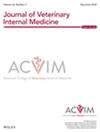Evaluation of Owner-Reported Clinical Signs and Fecal Occult Blood Tests as Predictors of Equine Gastric Ulcer Syndrome in Competition Dressage Horses
Abstract
Background
Equine gastric ulcer syndrome (EGUS) adversely affects the health, welfare, and performance of sports horses, requiring gastroscopy for definitive diagnosis. Owners frequently consider girth aversion as highly suggestive of EGUS.
Objectives
To evaluate whether owner-reported clinical signs or fecal occult blood tests (FOBTs) can help identify horses needing gastroscopy for EGUS diagnosis or monitoring treatment, thereby reducing unnecessary procedures in unaffected horses.
Animals
Eighty competition dressage horses referred by veterinarians for EGUS evaluation.
Methods
Case–control study including questionnaire, clinical examination, gastroscopy, and FOBT. Based on gastroscopic findings, horses were classified as cases (presenting equine squamous gastric disease, equine glandular gastric disease, or both) or controls (no lesions). Nineteen horses underwent a follow-up examination after EGUS treatment. Predictive values of clinical signs and fecal hemoglobin were assessed using the Wilson–Brown method, and group differences were analyzed using Mann–Whitney and Fisher's exact tests.
Results
Fifty-five horses (69%) had EGUS. The most commonly reported clinical signs in this cohort included girth aversion (78%), poor performance (33%), and weight loss (30%), with no differences between groups (p = 0.44–0.99). Neither clinical signs nor FOBT had sufficient sensitivity or specificity for EGUS screening. Among the 19 horses reevaluated after treatment, resolution of clinical signs did not reliably predict mucosal healing, with poor agreement between owner-reported clinical response and gastroscopic outcome.
Conclusions and Clinical Importance
In competition dressage horses, owner-reported clinical signs and FOBT results are unreliable predictors of EGUS or treatment outcomes. Gastroscopy remains essential for accurately diagnosing and monitoring EGUS in sports horses.


 求助内容:
求助内容: 应助结果提醒方式:
应助结果提醒方式:


